Rhipsalidopsis: varieties, difference from Schlumberger and care
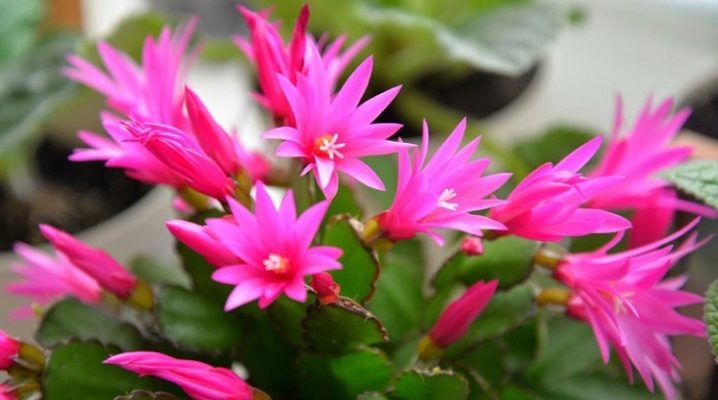
Cacti are one of the most popular plants used to decorate a house or apartment. Tired of the classic prickly designs, you can turn your attention to Ripsalidopsis - bright flowering plant without thorns.
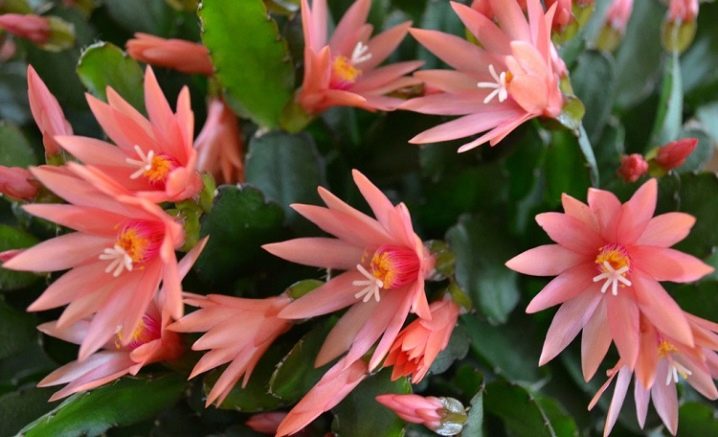
What it is?
Rhipsalidopsis is a plant from the Cactus family, the name of which literally translates as "whip-like berry cactus". The people also often use the names Easter Egg, Easter Cactus or Forest Cactus. Sometimes Ripsalidopsis is confused with Schlumberger, but, in fact, they are completely different members of the family. But it is very easy to distinguish it from an ordinary cactus, because the characteristic features of the plant are the absence of thorns and dense skin.
In nature, zygocactus develops not on the ground, but on trees, including sick or old ones. A different plant in this sense is only a support contributing to a better and more efficient development of the root system. The cactus accumulates moisture and useful elements in unusual thickened stems, which are divided into wide leaf-shaped plates. Throughout the entire growth process, some of them are outweighed over the edge of the container.
The cactus flower grows at the ends of the shoot either in March or April, depending on the variety of the plant.
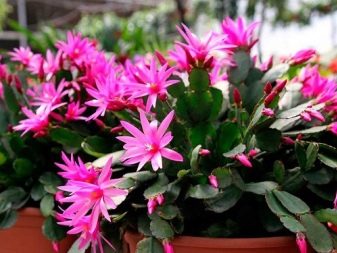
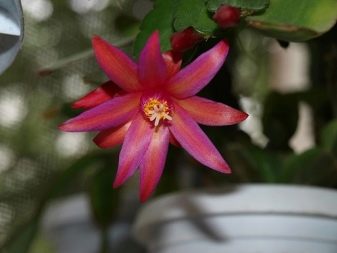
Although the flowering process itself lasts up to two months, the lifespan of an individual inflorescence is no more than a couple of days. The diameter of the opened bud varies from 5 to 8 centimeters, and from 1 to 3 specimens are formed on each shoot. The petals of the flower are very neat and narrowed, with a sharp tip, which makes the opened flower look like a beautiful star. They can be painted in scarlet, burgundy or white. Although the color palette is not very wide, each shade looks very rich and tasty.
The height of the bush reaches 30 centimeters, moreover, it is characterized by sufficient branching. Some stems are 5 centimeters long and can be up to 3 centimeters wide. Usually a cactus is painted in a light salad shade, but after being exposed to prolonged exposure to sunlight, it can change its color to a variety of red. The top of the ripsalidopsis is crowned with a collection of axillary buds, from which a bunch of whitish bristles grow. After the cactus has finished flowering, the buds are replaced by soft fruits, painted in a pale red hue and resembling a pentahedron.
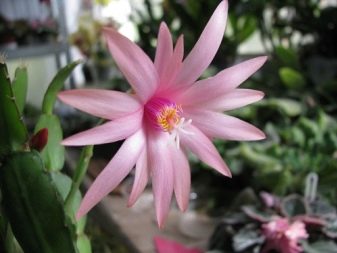
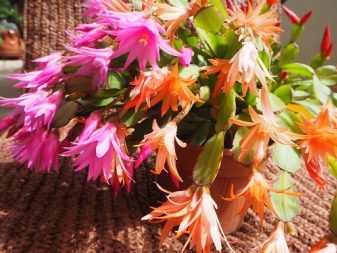
How is it different from Schlumberger?
Sometimes Ripsalidopsis is confused with Schlumberger, popularly known as the Decembrist. The main differences are manifested in the flowering conditions of the cactus - the Decembrist blooms in winter, and the Easter Egg blooms from spring to summer. Some differences are noticeable in the appearance of the plants. Rhipsalidopsis has smoothed projections at the edges, and Schlumberger's has sharp teeth.
Moreover, in the former, flowers grow with an even radially symmetrical corolla, in the latter, with beveled corollas.
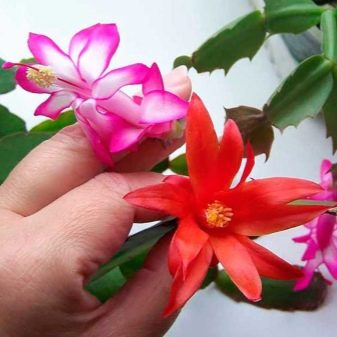
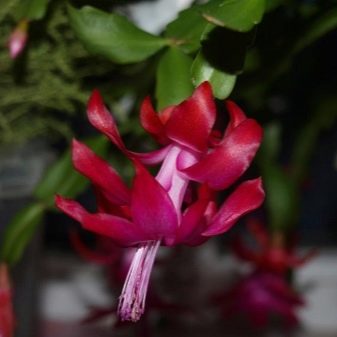
Types and their characteristics
In home floriculture much more popular are those varieties of ripsalidopsis that are bred by breeders, and not grown in natural conditions. They are usually characterized by bright colors and strong odors. Among the "domesticated" specimens, Gartner's and pink ripsalidopsis are popular. Gartner's cactus reaches a height of 20 centimeters. The length of the sheet-like plates ranges from 5 to 7 centimeters, and the width ranges from 2 to 2.5 centimeters.
The edges of these segments are slightly wavy. The bristles are yellow and sometimes appear completely transparent. The shade of the flowers themselves can be red, orange and expressed by other "fiery" variations.
At night, the buds are partially closed.
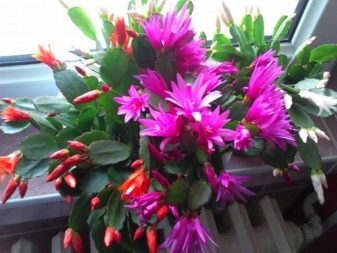
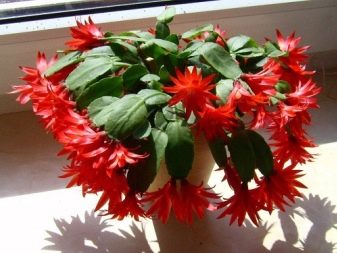
Cactus pink has a height of 15 centimeters, and the length of the shoots ranges from 25 to 30 centimeters. The length of the leafy processes does not exceed 5 centimeters. They are both smooth and slightly ribbed, and always with denticles on the edges. Crimson petals with yellow bases reach a diameter of 5 cm.
Other popular varieties include Ripsalidopsis Graesericharacterized by a lilac hue and bright yellow stamens, white ripsalidopsis Sirius and crimson Andromeda with an orange center.
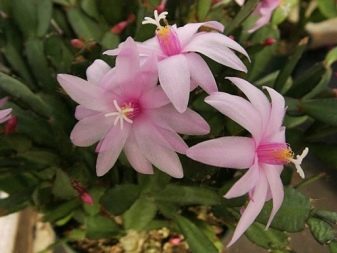

How to choose?
When choosing a cactus in a store, it is important to pay attention to the visual stability of the plant, as well as the presence of incomprehensible spots, traces of rot and other symptoms of diseases. It is especially important to keep an eye on this in winter, after all, transportation and adaptation only increase the already existing stress of the plant, and if it is infected, then it is quite possible that it simply will not survive the path from the store.
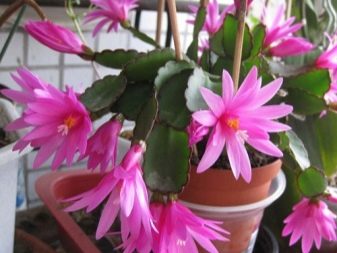

How to grow?
To force a plant to develop effectively, it needs not only to provide thoughtful care at home, but also to initially create the required conditions. The cactus should be placed on the windowsill facing the northeast or northwest. If this is not possible, and the window looks to the southeast or southwest, then it is important to move the pots a meter or one and a half from the glass. In summer, it is recommended to take the plant out into fresh air, additionally protecting it from precipitation, drafts and direct exposure to ultraviolet radiation. Alternatively, the flowerpot can be placed under a tree.
At the time of flowering, any movement of flowerpots is excluded. The slightest movement threatens to wither away the buds.
When flowering is complete, on the contrary, it is recommended to unfold the cactus from time to time to ensure more even crown development.


Temperature regime
While the growing season and flowering are in progress, the cactus must be kept at a temperature of 18 to 23 degrees. From about November to March, the temperature must be lowered to a range of 10 to 12 degrees, otherwise the buds will not appear next year. From the beginning of spring, the temperature gradually rises again. Ripsalidopsis suffers too high temperatures, as well as sharp temperature fluctuations, with negative consequences.
It is important to remember that the critical temperature for the dormant period is 8 degrees, and for the growing season - 15 degrees.


Lighting
The light for the cactus should be bright, but diffused. The plant will withstand light shade, but in this case you will not have to expect flowering. If the pot is located on the windowsill facing south, then Ripsalidopsis will have to be shaded.
In winter or in cloudy weather, you should think about additional illumination with specialized phytolamps.
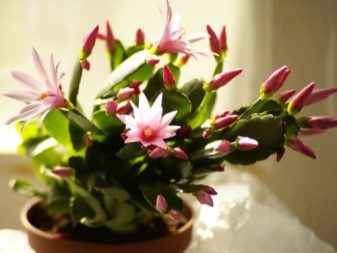
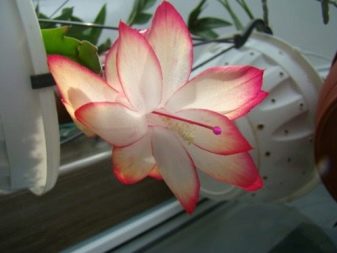
Air humidity
Air humidity should not be lower than 60%, and its increase is even encouraged. Every day in the morning or in the evening, and in the summer and several times a day, cactus stalks must either be sprayed or wiped with a damp cloth. It is important to keep track of so that the spray does not end up on the petals. Additionally, the base of the stem can be covered with a layer of moistened sphagnum moss or coconut fiber. It is also recommended to purchase a complete humidifier or just place bowls of water on the windowsill.
Sometimes Ripsolidopsis should be bathed in a warm shower, but not at the moment when it blooms.
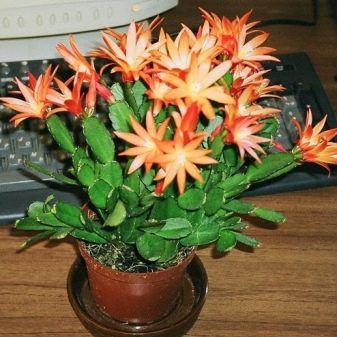
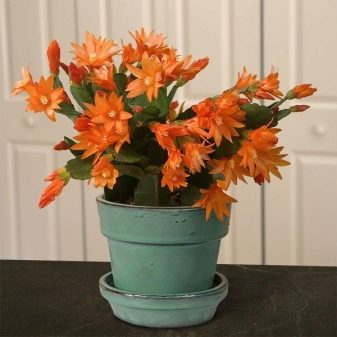
Top dressing
They begin to feed the cactus from the end of February. Until flowering begins, this has to be done once every 3 or 4 weeks. It is best to purchase liquid solutions or special granules that are designed for cacti and succulents. When bloom begins the frequency of fertilization will have to be increased to approximately once every 2 weeks. Ripsolidopsis categorically does not accept organic fertilizing containing a large amount of nitrogen. In addition, calcium is also banned.
The optimal feeding contains a part of nitrogen, 2 parts of phosphorus, 3 parts of potassium and, if desired, a vermicompost base.
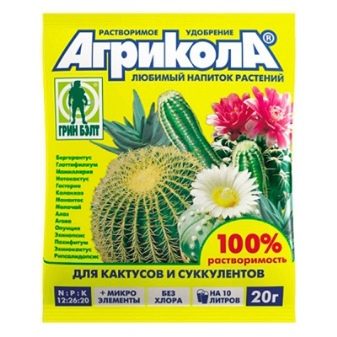

Watering
Ripsalidopsis cactus must be irrigated abundantly both during the growing season and during flowering. However, an excess of liquid will lead to stagnant processes in the soil, which, in turn, results in rotting of the root system. Therefore, each time, after completing watering, you need to wait about half an hour, and then pour excess water out of the pan... The liquid should be warm, between 28 and 30 degrees Celsius. You can pour it directly onto the stems, but never onto the flowers.
The irrigation frequency is determined by the condition of the soil. As soon as the topsoil has dried out 2-3 centimeters in depth, you can start watering again. This usually happens every 2 or 3 days. The most successful water - melt or rain, but if it is not available, then you can take a regular tap, then boil it or filter it.
A longer option for water preparation is to settle it for one day with the preliminary addition of citric acid or apple cider vinegar.
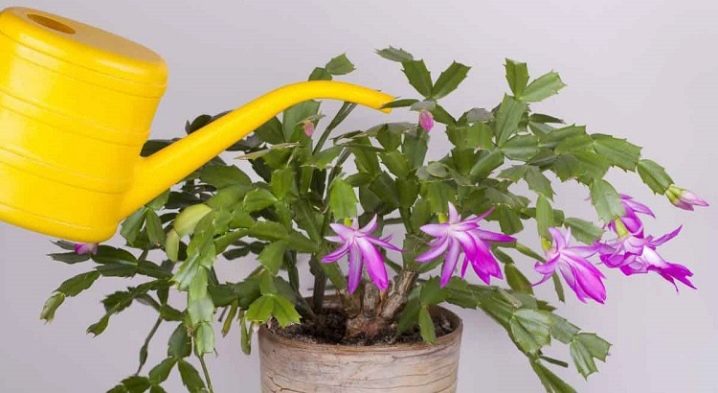
Fight disease
Gray rot disease is defined by the appearance of gray, weeping spots on the leaf-shaped segments, on which ashy and sometimes black villi grow. To save a cactus, it will immediately have to be transplanted, replacing both the pot and the soil, and first removing all damaged parts. Next, for four weeks, Ripsalidopsis will need to be watered with solutions such as "Skor" or "Kuprozan". Additionally, the plant can be treated with "Fundazol". The occurrence of root rot is signaled by black mucus on the stems and roots. In this case, the cactus will also have to be transplanted, but additionally intact parts will have to be disinfected in a fungicide solution, and the decaying ones will have to be removed. Of the drugs, "Gamair" and "Fitosporin" are suitable.
Late blight, which stops the development of the plant, is not cured - the cactus will have to be thrown away. At an early stage of the disease, however, you can try to influence the "Albit" or "Quadris" in conditions of complete isolation. The same is true for fusarium, the symptoms of which are watery spots, black mesh and the appearance of mold.



Reproduction
For the propagation of a cactus, 2 main methods are most often used - cuttings or planting seeds.

Cuttings
In this case, a strong shoot containing 3 segments is selected on a plant that has reached the age of 3 or 4 years. Having carefully unscrewed it, the wounds must be immediately treated with chalk or crushed coal. Then the cutting is dried for a couple of days and planted in a plastic cup filled with a special soil mixture. Additionally it is worth using growth stimulants.
In about a week, the roots will appear, and the cactus can be transplanted into a regular pot.

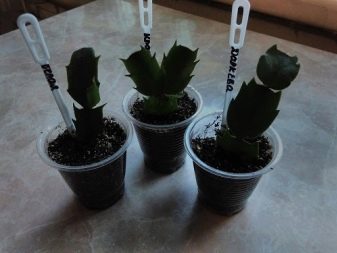
Vaccination
Reproduction of cacti by grafting is possible, but not recommended. Since the process is quite laborious and difficult to implement at home, it is only suitable for specialists engaged in breeding.

Seeds
The seeds are extracted from the fruits of Ripsalidopsis and laid out on a moistened mixture of leafy earth and sand, mechanically deepening a couple of millimeters. The container is tightened with polyethylene, heated from below and illuminated with diffused light. The soil is regularly sprayed with a liquid containing a growth stimulant, and also aired for half an hour. A couple of months after the emergence of sprouts, cacti can be planted in containers.
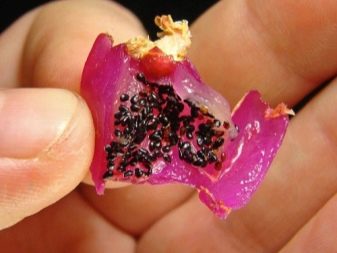
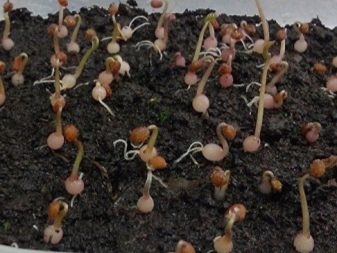
Florist tips
When choosing Ripsalidopsis for decorating a room, experts recommend not limiting yourself to a single plant, but using a mix of several varieties. Caring for cacti is not particularly problematic, besides, the specimens get along well with each other, which means a combination of several cacti will be advantageous in every sense. It is better to replant the plant immediately after flowering, that is, at the junction of May and June.
Young bushes undergo such a procedure every year, and for adults it is enough to change places every couple of three or even at 5 years.
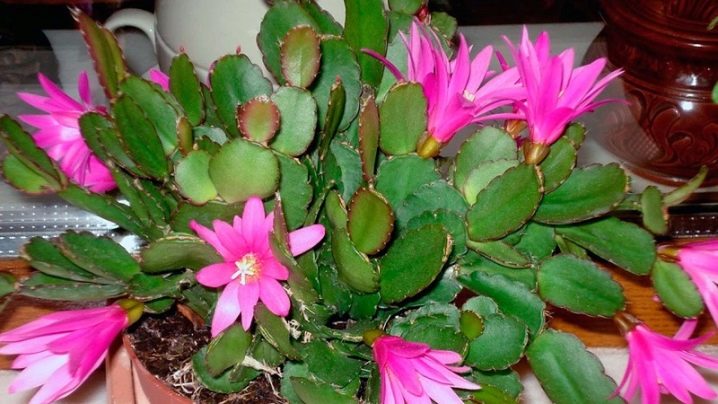
See below for more details.















































The comment was sent successfully.